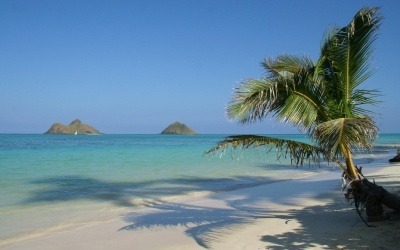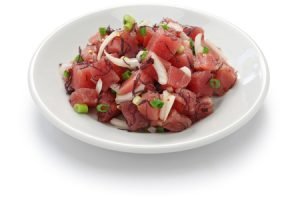
What is it about Hawaiian cuisine ? It had been the Sandwich Islands but that is not foodie reason. The US state of Hawaii, a diverse group of islands, brings together a diverse range of very different ethnic cuisines based on American, British, Filipino, Chinese, Japanese, Vietnamese, Cambodian, Korean, Polynesian and Portuguese traditions. Such culinary diversity offers a range of new experiences best described as the ultimate cross-over with a strong Asian influence.
We find a range of spices for example represented by all the continents:-
Asian teriyaki, Chinese five-spice powder, wasabi, Japanese soy sauce, Filipino bagoong (fermented fish or shrimp and salt), and Huli-Huli sauce (ginger, soy sauce, red chiles, salt and water). Hawaiian sea salt is a traditional seasoning for native Hawaiian dishes such as kālua pork (wrapped in tī or banana leaves and roasted in an underground pit), poke and Hawaiian jerky (beef made with soy sauce and sometimes pineapple juice). Alaea (volcanic red clay) enriches the salt with iron oxide and imparts a characteristic red colour.
A variety of fruits are used extensively in Hawaiian cooking such as pineapple, papaya , guava, bananas, grapes, mangoes, litchi and jaboticaba (a sweet, grape-like fruit). Coconuts are extremely popular in Hawaiian cuisine and are used for coconut-based gelatin and pudding, and even doughnuts with coconut filling.
Fish-based meals are extremely popular in Hawaii. Lomi-lomi salmon is a traditional side dish made with salted and diced salmon, crushed ice, tomatoes and Maui onions. Mahi-mahi is prepared in a variety of ways, including breaded with macadamia nuts and baked or fried, or teriyaki-style.
The art of fermentation is a long tradition on the islands. It is a classic method of preservation and was one of the main ways to extend the nutritional value of food because they had no cool places for this purpose. Most meats were heavily salted or were dried in the sun.
Poke

Another local cult favourite is a raw salad usually served as a starter called poke (pronounced POH-kay). Traditionally, fishermen cut their raw fish into cubes and then added whatever seasonings came to hand. So a raw fish is doused with seasonings such as soy sauce, green onions, inamona (roasted crushed candlenut), sesame oil, limu seaweed and chopped up chillis, all served as bite-sized cubes.
Most fish can be made into poke, most popularly tuna especially the Big-Eyed and Yellow Fin tuna, known as Ahi in Hawaii. We also find lobster, octopus heʻe(tako) and snapper. Poke appears like Japanese sashimi and is often served at social gatherings, the luaus, but poke is also sold in various retailers, even with poke bars offering a variety of flavours. Poke is usually served in bowls rather like deconstructed sushi with plenty of rice and vegetable toppings like sliced cucumber. Take for example, limu ahi poke (seaweed) and inamona poke (kukui nut) which add style to the kimchi- and Maui onion poke. Most Hawaiians would except that Poke without some form of seafood in its mix is probably a form of cultural misappropriation.
Kalua Pig
Pig is the food eaten at mainly religious ceremonies and events in Hawaiian culture. Only men were allowed to eat this meat apparently and the same restrictions were also applied to bananas and coconuts. The cooked pig was offered up and the men could not take this food until a fair portion had been taken.
For the carnivores amongst us, Kalua Pig is a the Hawaiian variant on pulled cooked pork. Helena’s Hawaiian Restaurant makes great play of serving this dish along with Lomi Salmon. The pork is normally cooked in an oven dug into the ground which is known as an imu. It relies heavily on smoke to impart a classic flavour.
The pork needs to be covered with leaves and stones during the cooking process so that it maintains moisture and doesn’t go horribly dry like a bad roast. Apparently even the stones must be carefully used otherwise they explode with the heat. The cooking process takes many hours. There are conventional recipes which set out to use the classic American Trager barbecue but there is no substitute for this type of approach to cooking. I would use a slow cook device like a CrockPot for this type of role.
Lomi Lomi Salmon
Whilst fish is a major player in Hawaiian cuisine one dish that stands out is Lomi Lomi Salmon. It is normally served as a side dish and is prepared with salmon that is quite salty, onions, tomatoes and green onions. The salmon is often shredded to help more of the flavour infuse the pink cooked flesh. Again very simple fare where all the ingredients are roughly chopped and mixed together so the flavours infuse with each other. It looks more like a cold soup and needs to be eaten with a spoon.
Loco Moco
The breakfast dish is loco moco, made of rice, hamburger patties, fried eggs and brown gravy and a popular drivers product in Hawaii. The quintessentially Hawaiian “plate lunch” consists of rice, macaroni salad and a main course or entrée, usually teriyaki beef or chicken katsu (fried boneless chicken served with tonkatsu sauce where the sauce is made with soy sauce, Worcestershire sauce and mirin).
Malasada Day – an absolute pleasure is Portuguese malasada, which is a light, fluffy, fried doughnut coated with sugar, sometimes filled with jelly or cream. Hawaiians celebrate Fat Tuesday this way ! The popular traditional coconut milk dessert is haupia, which is a thick coconut-cream solidified with Polynesian arrowroot, sliced and served into blocks. It is used as a topping for white cakes especially celebrating those who are hitched.
The Japanese also brought the shave ice which is enjoyed throughout the islands. Back then, Japanese workers would shave ice using a knife or machete and then pour a variety of syrups and juices over them to refresh them in the burning sun.
At the moment, Hawaiian cuisine remains firmly entrenched in the islands and specialist restaurants on mainland USA. We may see it develop in time. Poke for example clearly has a lot of healthy connotations associated with it because of the combination of seafood and vegetables with rice.

Brilliant holiday and loved the food.
I agree, the cuisine angle adds something special to these islands. There is plenty to explore, especially where the fish dishes are concerned. Let me know if you find any good recipes to try from these islands.